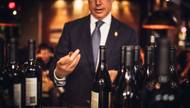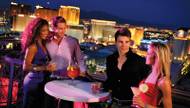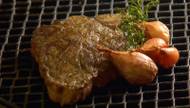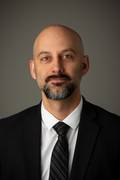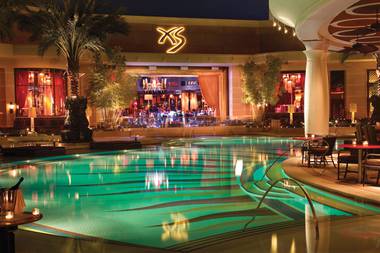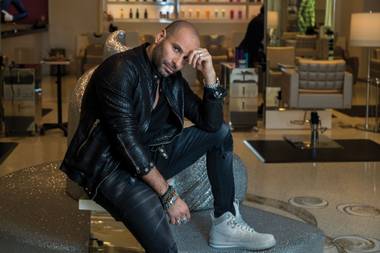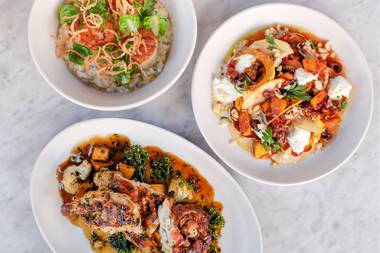There are dozens of world-famous chefs operating restaurants on the Las Vegas Strip, yet it’s easy to understand which ones are real pioneers. Hubert Keller is the epitome of the word “visionary,” having remade the restaurant rules for decades in Vegas, San Francisco and beyond.
When “California cuisine” had taken hold in San Francisco in the ’80s, Keller’s Fleur de Lys distinguished itself with a healthy dose of innovation blended into a classic French approach. Seemingly small moves like writing the menu in English, putting female servers in the dining room—believe it or not, it wasn’t happening much back then—and installing vegetarian menus turned out to be game-changers.
In Las Vegas, he was the first to put a DJ booth in a restaurant at what is now Fleur at Mandalay Bay, and more famously, Keller started the gourmet burger trend on the Strip with the excellent and fun Burger Bar. It’s no wonder that when he recently returned to Top Chef, chef-testants couldn’t wait to express respect and admiration. “It’s the same respect I had and still have for my mentors, the people who were on top of the game in their time,” he says.
Keller, who is currently filming new episodes of his PBS show Secrets of a Chef in Las Vegas and around the world, says innovation and inspiration comes with knowledge and experience. “Instead of spending time trying to figure out what comes next—which is where people very often are failing because they end up copying something that just pops up—try to step back. Be yourself. And figure out with your guests and employees what you can do better. Where is that trigger that will lead you to something new? That is when you become the leader.”
You were a big part of the most recent season of Top Chef, where you reopened Fleur de Lys in San Francisco for one last meal in which the contestants tried to re-create your famous food. That must have been an emotional experience. For me and my wife it was very personal. One of the producers who had been with the show since the beginning was part of the first-ever episode, which was filmed at Fleur de Lys in San Francisco. They finally decided to come back to California for this season, so she calls me up after all these years and said she would like to film an episode at the restaurant. I said great, but the restaurant has been closed for a year already! She was very sorry she didn’t know, but it was good news. The last night when we closed the restaurant, everyone said it was a celebration better than a New Year’s Eve party, so after talking on the phone we thought about that and decided we could reproduce that closing. It was a lot of work to [put things back together] but very exciting to have it all on film. It’s probably the best souvenir you can have. And the ratings for that episode were through the roof.
What’s it like to be around so many young chefs, like those on Top Chef, who show so much admiration for you and what you’ve accomplished? I don’t like to talk that much about myself, but yes, it’s really nice. I just did some events in Cancun and in Maui for Food & Wine and the James Beard Foundation and working those events with younger chefs, I’m on a stage where I don’t think about much, but those young chefs are looking at me, and I’m being introduced as a legend, and it’s strange because I’m not dead yet, right? (Laughs) I feel like I’m the same age. But getting that respect, that back-of-the-house satisfaction, it makes me feel really good. Even the winner of Top Chef this year said his highlight of the show was cooking at Fleur de Lys and asking me questions about how those dishes, how we came up with them. That makes me feel good.
You made many moves in San Francisco that were very influential. How do you decide when and how to make changes to your restaurants? The process is probably not to try too hard to figure out what’s next. ... When we took over Fleur de Lys in San Francisco, a very upscale, French, white-tablecloth restaurant, we were the first in the U.S. to introduce a vegetarian tasting menu. Every restaurant had a tasting menu, but we wanted to set up a beautiful vegetarian menu so those people could have the same experience as every guest at the table. It was really just listening and trying to understand the customer. You have a party of five, why would you punish one person with rice and broccoli? Today it sounds like nothing special but in those days no one would even touch it. Instead of trying to figure out what someone else came up with, you concentrate your energy on that, stepping back, looking at where you are and who are your guests, finding the need. There’s always something new out there, and it’s not a home run every time you try but at least you are trying to be different.
Has it surprised you how dining has become a pivotal part of the entertainment experience in Las Vegas? I would say no. I used to go to Vegas way before I actually had a restaurant here. We used to do field trips a couple times a year to see the chefs and restaurants and the experience. I could sense, like when I first came to California, that I was in a spot where it was happening. And that it was not just a trend, but it was going to be here to stay. It’s been a very quick evolution in Las Vegas to a real restaurant city. Twelve years later, I’m still here, going strong, and just as excited if not more than before.

